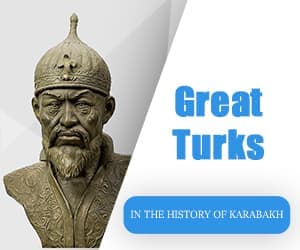Western Zangezur, just a few generations ago densely populated by the Turks and Kurds, was transferred to Armenia “on the basis of a national majority.” On the same basis, an Armenian autonomy was created in Nagorno-Karabakh, which later served as the basis for the formation of the unrecognized “Republic of Artsakh”. Below are 10 facts, supported by documents, about the methods by which the Armenian majority was formed in these areas of the former Karabakh Khanate.
1) In the first two decades of the 19th century, Armenians made up about 20% of the population of Karabakh. This is evidenced by the official documents of the Russian Empire (document of the Ministry of Internal Affairs of 1811 and a document on taxation of 1823).
2) In 1828-1830, the Russian authorities resettled about 140 000 Armenians from Iran and Turkey to the South Caucasus. Most of them were stationed in Karabakh. The migration of Iranian and Turkish Armenians, albeit on a smaller scale, continued throughout almost the entire 19th century. They were resettled by whole communities, which created their own villages in Karabakh, for example, in the late 1850s – early 1860s, the village of Arakul in the territory of the present Khojavend district.
3) The authorities provided the best lands to the Armenian settlers. In many cases, these migrants from Iran and Turkey drove out the indigenous Turks, occupying their homes (testimony of Griboyedov and data of the historian Gazaryan). They received tax exemptions and financial assistance from the state. All these benefits did not apply to Muslims. Such comfortable conditions ensured an increase in the birth rate in the Armenian environment of Karabakh.
4) As a result of mass migration from Iran and Turkey in the 1830s, the share of Armenians in Karabakh increased to 33%. And by the end of the 1880s, due to demographic growth, they already prevailed in Shusha (60%) and the largest of the four districts formed on the lands of the former Karabakh Khanate, Shusha (54.5%). In Zangezur, which was then part of Karabakh, the Armenians made up half of the population. The Turks remained in a clear majority in two of the four counties – Jebrail and Jevanshir (70-75%). In 1889 as a whole in Karabakh, there were 54.4% Muslims, 45.5% Armenians.
5) In the late 19th – early 20th centuries, the effect of the mass migration of Armenians in 1828-1830 began to weaken, as well as the subsequent demographic boom among them. In 1889-1914, the ratio of the two main population groups on the territory of the former Karabakh Khanate stopped changing in favor of the Armenians. On the whole in Karabakh, their share decreased from 45.5% (1889) to 41% (1914); in Shusha – from 60% (1889) to 51% (1914); and the share of Muslims increased from 40% to 44%. In Zangezur, the share of Armenians decreased from 49% (1889) to 43% (1914); the proportion of Muslims increased from 50% to 56%. In Jebrail and Jevanshir districts, Muslims retained the majority in the range of 65-75%.
6) If the demographic dynamics of 1889-1914 continued and were not interrupted by the collapse of the Russian Empire in 1917, in the next few decades the share of Armenians in the population of Karabakh would have decreased to 35-30%.
7) The Armenian Republic, proclaimed in 1918 under the leadership of the nationalist Dashnaktsutyun party, sought to expand its territory at the expense of regions populated mainly by Muslims. For this, a policy of extermination and expulsion of Muslims was carried out in order to provide the artificial Armenian majority there.
8) The representatives of the Dashnaktsutyun party first introduced the term “Nagorno-Karabakh”. The goal was to separate the Shusha district, where Armenians accounted for about 50%, from the rest of Karabakh, where the share of Muslims reached 70-75%.9) In 1918-1920, the Dashnaks actively carried out ethnic cleansing in the Zangezur and Shusha districts of Karabakh. “The peaceful Muslim population is being mercilessly destroyed and many villages are burnt down,” Usubbekov, head of the government of the Azerbaijan Democratic Republic, reported to the command of the Western powers in the South Caucasus in December 1919. By March 1920, in Zangezur alone, up to 40 Muslim villages had been destroyed; 60 000 Muslims became refugees. A mass exodus of the Turkic population also took place from other regions of Karabakh, for example, from the Javanshir district.
10) By expelling tens of thousands of Muslims and destroying more than fifty Muslim villages in Nagorno-Karabakh and Western Zangezur, the Armenian majority was secured. This became the basis for the transfer of Western Zangezur to Soviet Armenia (1920) and the formation of Armenian autonomy in Nagorno-Karabakh (1924). “Nagorno-Karabakh was separated from Azerbaijan into the Autonomous Region on the basis of a national majority: 94.4% of its inhabitants are Armenians, 5.6% are Turks,” an Armenian author noted in 1924. And this despite the fact that just ten years before that, in the territories given over to the Autonomous Region, Armenians made up 53 to 26.7%, and a hundred years ago – no more than 20%.
All the listed facts are gleaned from official documents and academic publications of Armenian historians. Scans of these documents and scientific materials can be found at the Qarabag.com website in the article “Documents reveal the secret of the “Armenian miracle” of Karabakh“.




